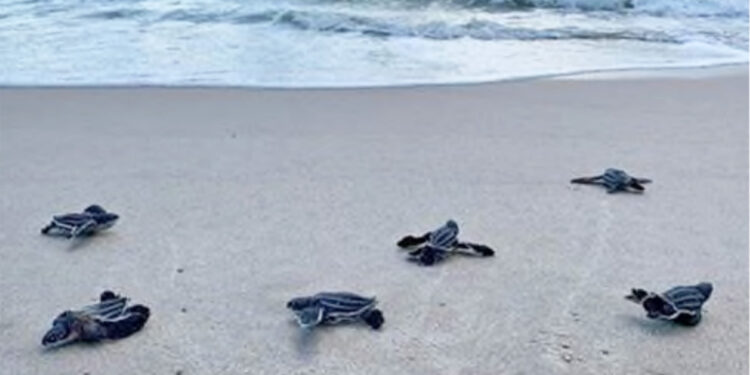The 2023 sea turtle nesting season in Indian River County has set a new record with 12,771 nests, surpassing the previous year’s count of 9,242 nests. This significant increase occurred within a 22.4-mile stretch of coastline, monitored under specific permits.
The nesting season, which spans from March 1 to October 31, witnesses the arrival of three distinct sea turtle species. Remarkably, each turtle can lay up to six nests per season, with each nest holding 80-120 eggs. Loggerhead and Green sea turtles experienced a significant year.
A breakdown of the nesting data reveals interesting trends:
- Leatherback sea turtles, the largest species, have laid 27 nests, a decrease from the 101 nests in 2022.
- Loggerhead sea turtles, the most common in the area, created 8,639 nests, a 15% increase from last year.
- Green sea turtles, known for consuming seagrass, have shown a remarkable 55% increase from their previous record in 2017, laying 4,105 nests.
Monitoring sea turtle activities is challenging, highlighting the importance of consistent conservation efforts. These marine reptiles undergo long migrations, spanning thousands of miles, returning to their birth beaches for nesting. It can take 20-30 years for a turtle to mature enough for egg-laying.
The Endangered Species Act of 1973 was vital in providing necessary protections to sea turtles, which were listed as “threatened and endangered” due to critically low populations. Their endangerment was primarily due to unregulated hunting and habitat destruction.
Nearly five decades later, the results of conservation efforts are evident in the record-breaking nesting numbers in Indian River County. However, fluctuations in nesting numbers are typical, and species-specific variability exists. The Florida Fish and Wildlife Conservation Commission will soon compile and release statewide nesting data.
The U.S. Fish and Wildlife Service and other partners continue to evaluate and protect threatened and endangered species. Despite the current success, these species are still on a path to recovery.
For more information, the public can visit the Natural Resources Department’s webpage, noting that all activities are conducted under Marine Turtle Permits #166 and #261.
Leatherback
The leatherback sea turtle, renowned as the world’s largest turtle, is unique for its scale-less, soft shell, a characteristic that sets it apart from other sea turtles. Its resilient, rubber-like skin has been a defining feature since the dinosaur era. Known for their extensive migrations, leatherbacks can travel over 10,000 miles annually between their nesting and feeding areas. These turtles are not only long-distance swimmers but also remarkable divers, capable of reaching depths nearly 4,000 feet, surpassing most marine mammals.
Leatherbacks boast the most extensive geographical range of any reptile, primarily nesting on tropical and subtropical beaches. Although once widespread in all oceans, except the Arctic and Antarctic, their numbers are now diminishing globally. They confront numerous dangers, both on land and at sea. The most significant threats include accidental capture in fishing gear, direct hunting, and egg harvesting for human consumption.
Loggerhead
The loggerhead turtle, recognized for its distinctively large head housing robust jaw muscles, is adept at consuming hard-shelled prey like whelks and conch. In the United States, loggerheads represent the most prevalent sea turtle species that nest along the coasts, especially in Sebastian and Vero Beach. Both juvenile and adult loggerheads inhabit U.S. coastal waters, yet many adults that nest on U.S. shores migrate from neighboring countries, including the Bahamas, Cuba, and Mexico.
Historically, loggerhead populations in the U.S. have suffered declines due to unintended capture in various types of fishing gear, such as trawls, gillnets, and longlines. Implementing turtle excluder devices (TEDs) in shrimp trawls, restrictions on gillnets, and modifications to other fishing gear have helped decrease the incidental catch of sea turtles in some fisheries. Nevertheless, accidental capture in fishing gear remains the primary threat to loggerhead turtles.
Green
The green sea turtle stands out as the largest of the hard-shelled sea turtles. Distinguished by their herbivorous diet, they primarily consume seagrasses and algae. This unique diet imparts a green hue to their fat, which interestingly is the origin of their name rather than the color of their shells.
Globally distributed, green turtles have a presence in numerous regions. They are known to nest in over 80 countries while inhabiting coastal zones in more than 140 nations. Historically, these turtles faced significant threats due to exploitation for their fat, meat, and eggs, leading to declines in their populations worldwide. In response, many countries, including the United States, have enforced bans on the killing of sea turtles and the collection of their eggs. Despite these protections, in certain regions, green turtles still face dangers from being hunted for meat or their shells, which are trafficked in the wildlife trade.
The primary challenges confronting green turtles today include:
- Bycatch in both commercial and recreational fishing gear.
- Collisions with vessels.
- Habitat loss due to coastal development.
- The impacts of climate change.
These factors continue to pose significant threats to the recovery and conservation of green sea turtles.







